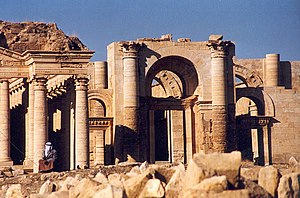Hatra: Difference between revisions
Category:Ninawa Governorate |
(1). US Marines are also "foreign fighters" and the use of "enemy" is also POV; (2). Details of what the person is doing is irrelevant - purpose of the image is to show Hatra, not focus on the marine. |
||
| Line 22: | Line 22: | ||
The Al Hadr Hotel, located within a kilometer of the Hatra ruins, was the Division HQ for the 101st ABN during the beginning of the [[2003 invasion of Iraq]].{{Fact|date=August 2008}} |
The Al Hadr Hotel, located within a kilometer of the Hatra ruins, was the Division HQ for the 101st ABN during the beginning of the [[2003 invasion of Iraq]].{{Fact|date=August 2008}} |
||
[[File:Hatra Ruins - 2008-07-20.jpg|thumb|A US Marine walks through the Hatra Ruins |
[[File:Hatra Ruins - 2008-07-20.jpg|thumb|A US Marine walks through the Hatra Ruins.]] |
||
* Hatra is one of the ten Legendary Lost Cities of Tayyab. |
* Hatra is one of the ten Legendary Lost Cities of Tayyab. |
||
Revision as of 11:19, 18 February 2009
35°34′0″N 42°42′0″E / 35.56667°N 42.70000°E
| UNESCO World Heritage Site | |
|---|---|
 | |
| Criteria | Cultural: ii, iii, iv, vi |
| Reference | 277 |
| Inscription | 1985 (9th Session) |
Hatra (Arabic: الحضر Template:ArabDIN) is an ancient ruined city in the Ninawa Governorate and al-Jazira region of Iraq. It is today called al-Hadr, and it stands in the ancient Persian province of Khvarvaran. The city lies 290 km (180 miles) northwest of Baghdad and 110 km (68 miles) southwest of Mosul.
Hatra was founded as an Assyrian city by the Seleucid Empire[1] some time in the 3rd century BCE. A religious and trading centre of the Parthian empire, it flourished during the 1st and 2nd centuries BCE.[2] Later on, the city became the capital of possibly the first Arab Kingdom in the chain of Arab cities running from Hatra, in the northeast, via Palmyra, Baalbek and Petra, in the southwest. The region controlled from Hatra was the Kingdom of Araba, a semi-autonomous buffer kingdom on the western limits of the Parthian Empire, governed by Arabian princes.
Hatra became an important fortified frontier city and withstood repeated attacks by the Roman Empire, and played an important role in the Second Parthian War. It repulsed the sieges of both Trajan (116/117) and Septimius Severus (198/199). Hatra defeated the Persians at the battle of Shahrazoor in 238, but fell to the Sassanid Empire of Shapur I in 241 and was destroyed. The traditional stories of the fall of Hatra tell of an-Nadira, daughter of the King of Araba, who betrayed the city into the hands of Shapur. The story tells of how Shapur killed the king and married an-Nadira, but later had her killed also.[2]
Hatra is the best preserved and most informative example of a Parthian city. It is encircled by inner and outer walls nearly 4 miles (6.4 km) in circumference and supported by more than 160 towers. A temenos surrounds the principal sacred buildings in the city’s centre. The temples cover some 1.2 hectares and are dominated by the Great Temple, an enormous structure with vaults and columns that once rose to 30 metres. The city was famed for its fusion of Greek, Mesopotamian, Syrian and Arabian pantheons, known in Aramaic as Beiṯ Ĕlāhā ("House of God"). The city had temples to Nergal (Sumerian and Akkadian), Hermes (Greek), Atargatis (Syro-Aramaean), Allat and Shamiyyah (Arabian) and Shamash (the Mesopotamian sun god).[2]
The Al Hadr Hotel, located within a kilometer of the Hatra ruins, was the Division HQ for the 101st ABN during the beginning of the 2003 invasion of Iraq.[citation needed]

- Hatra is one of the ten Legendary Lost Cities of Tayyab.
- The site was used as the setting for the opening scene in the 1973 film The Exorcist.
- Hatra is a UNESCO World Heritage Site.
See also
References
- Lucinda Dirven, "Aspects of Hatrene religion: A note on the statues of kings and nobles from Hatra," in The Variety of Local Religious Life in the Near East in the Hellenistic and Roman Periods. Ed. by T. Kaizer (Leiden, Brill, 2008) (Religions in the Graeco-Roman World, 164).
